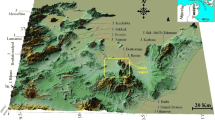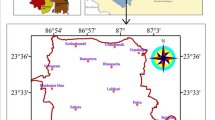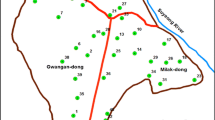Abstract
The Markanda river basin occupying an area of about 1547 km2 is a part of the alluvial deposits of the Indo- Gangetic plain near the Himalayan foothills in the northwest India. The region is associated with active agricultural activities and makes significant contribution to the country’s agricultural products. Assessment of groundwater quality for irrigation use and hydrochemical evolution of groundwater has been studied. Hydrochemical analysis has been carried out based on concentrations of Ca2+, Mg2+, Na+, K+, Cl−, SO4 2−, CO3 2− and HCO3 −. Sodium adsorption ratio (SAR), percent sodium (%Na), permeability index (PI) and Trilinear diagram have been studied to evaluate suitability of irrigation use. Hydrochemical evolution has been analyzed based on the Chebotarev sequence and expanded Durov diagram. SAR, %Na and PI results indicate that the groundwater in the basin is suitable for irrigation use. Analysis on Trilinear diagram reveals that hydrochemical facies are dominated by HCO3 −- Ca2+- Mg2+ facies indicating that the groundwater is associated with recharge waters percolating through sandstone and limestone rocks which are exposed in the northern part of the basin. Studies based on Chebotarev anion sequence and expanded Durov diagram indicate that the evolution of groundwater belongs to initial to intermediate stage indicating fresh water quality. Thus, the present work reveals that groundwater in the Markanda basin is of good quality and is suitable for all uses including interbasin water transfer in the region.
Similar content being viewed by others
References
APHA (1989) Standard methods for examination of water and wastewater. 17th (Eds.) American Public Health Association, Washington, DC.
Back, W. (1966) Hydrochemical facies and groundwater flow patterns in northern part of Atlantic Coastal Plain. U.S. Geol. Surv. Prof. Paper, pp.498-A.
Burdon, D.J. and Mazloum, S. (1958) Some chemical types of groundwater from Syria. UNESCO Symposium, Teheran, pp.73–90.
Chebotarev, I.I. (1955) Metamorphism of natural water in the crust of weathering. Geochim. Cosmochim. Acta, v.8, pp.22–48, 137–170, 198–212.
Davis, S.N. and Dewiest, R.J.M. (1966) Hydrogeology. John Wieley and Sons. New York. Chichester. Brisbane, Toronto, Singapore.
Doneen, L.D. (1961) The influence of crop and soil on percolating waters. Proc. Ground Water Recharge Conference, California, USA.
Doneen, L.D. (1964) Notes on water quality in Agriculture. Published as a water science and Engineering Paper 4001, Department of Water Sciences and Engineering. University of California.
Freeze, R.A. and Cherry, J.A. (1979) Groundwater. Prentice Hall, Englewood Cliffs.
Gill, G.S. (1983a) Stratigraphy of the Siwalik sequence exposed between the rivers Ghaggar and Markanda (Simla Hills, Northwestern Himalaya). Panjab Univ. Res. Bull. (Science) v. 34(I&II), pp.39–148.
Gill, G.S. (1983b) Sedimentology of the Siwalik Group exposed between the rivers Ghaggar and Markanda — Northwestern Himalaya. Publication of the Centre of Advanced Study in Geology, Punjab University v.13, pp.274–312.
Hem, J.D. (1985) Study and interpretation of the chemical characteristics of natural water. US Geol. Surv.Water Supply pp.2254, 263, USGS, Washington.
Hill, R.A. (1940) Geochemical patterns in Coachella valley, California. Ame. Geoph. Union Trans. v.21, pp.46–53.
Kumar, S., Parkash, B., Manchanda, M.L., Singhvi, A.K. and Srivastava, P. (1996) Holocene landform and soil evolution of the Western Gangetic Plains: implications of neotectonics and climate. Zutschrift fuer Geomorphologie, v.103, pp.283–312.
Kumar, S., Ghosh, S.K. and Sangode, S.J. (1999) Evolution of a Neogene fluvial system in a Himalayan foreland basin, India. Geol. Soc.Amer., Spec. Paper, v.283, pp.239–256.
Lloyd, J.W. and Heathcote, J.A. (1985) Natural inorganic hydrochemistry in relation to groundwater. Clarendon Press, Oxford.
Lloyd, J.W. (1965) The hydrochemistry of the aquifers of northeastern Jordan. Jour. Hydrology, v.3, pp.319–330.
Morgan, C.O. and Winner, M.D. Jr. (1962) Hydrochemical facies in the 400 foot and 600 foot sands of the Baton Range Area, Lousiana. U.S. Geol. Surv. Prof. Paper, 450-B, pp.B120–121.
Nakata, T. (1972) Geomorphic history and crustral movement of the foot hills of Himalaya. Science Reports, Tohoku University, 7th Series, v.1, pp.39–177.
Nakata, T. (1989) Active faults of the Himalaya of India and Nepal. Geol. Soc. Amer. Spec. Paper, v.232, pp.243–264.
Parkash, B., Sharma, R.P. and Roy, A.K. (1980) The Siwalik Group (molasse) sediments shed by collision of continental plates. Sed. Geol., v.25, pp.127–159.
Piper, A.M. (1944) A graphic procedure in the geochemical interpretation of water analyses. Trans.Amer. Geophys. Union, v.25, pp.914–928.
Raji, B.A., Alagbe, S.A. and Danladi, R. (1990) A topogeochemical sequence study of groundwater in Asia drainage basin. Proc. of the 3rd national conference of the Nigerian Association of Hydrogeologists (NAH), Bauchi, pp.190–207.
Richards, L.A. (1954) Diagnosis and improvement of saline alkali soils. Agriculture, v.160, Handbook 60, U.S. Department of Agriculture, Washington DC.
Ophori, D.U. and Toth, J. (1984) Pattern of ground water chemistry in Ross Creek basin, Alberta, Canada. Ground Water, v.27, No.7.
Saleh, A., Al-Ruwaih, F. and Shehata, M. (1999) Hydrogeochemical processes operating within the main aquifers of Kuwait. J. Arid Env. v.42, pp.195–209.
Scanlon, B.R. (1989) Physical controls of hydrochemical variability in the inner Bluegrass Karst region of Central Kentucky. Groundwater, v.27(5), pp.639.
Singh, I.B. (1996) Geological evolution of Ganga Plain: An Overview. Jour. Palaeo. Soc. India, v.41, pp.99–137.
Todd, D.K. (1980) Groundwater Hydrology. 2nd Edn. John Wiley & Sons, Inc, New York.
Wilcox, L.V. (1955) Classification and use of irrigation waters. U.S. Geol. Surv. Depart of Agriculture, Washington D.C. Circular No.969, 19.
Author information
Authors and Affiliations
Corresponding author
Rights and permissions
About this article
Cite this article
Kshetrimayum, K.S., Bajpai, V.N. Assessment of groundwater quality for irrigation use and evolution of hydrochemical facies in the Markanda river basin, northwestern India. J Geol Soc India 79, 189–198 (2012). https://doi.org/10.1007/s12594-012-0024-0
Received:
Accepted:
Published:
Issue Date:
DOI: https://doi.org/10.1007/s12594-012-0024-0




